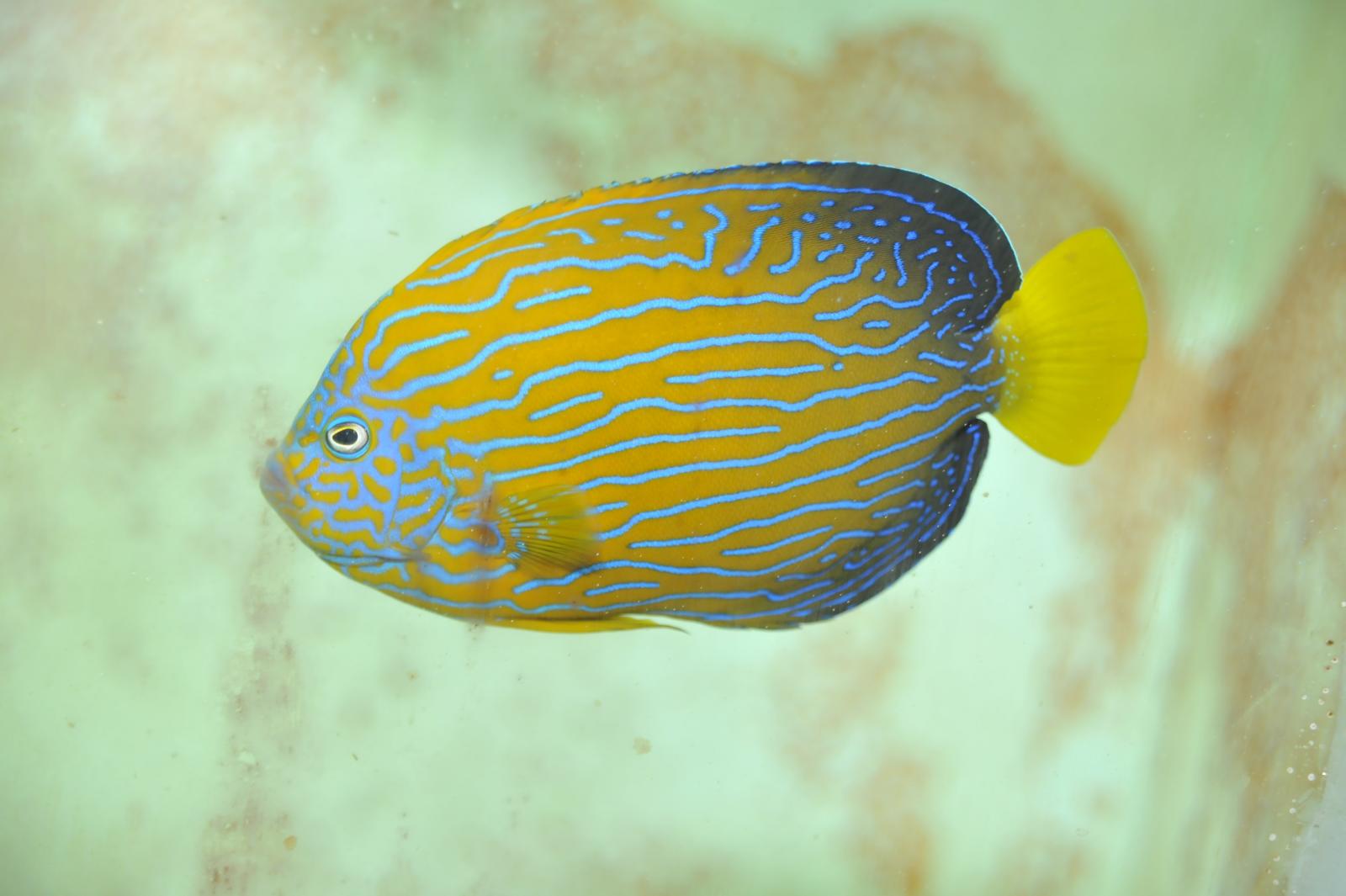The artificial propagation technology of blue belt purse fish fry has made a breakthrough, creating value and being good with the ecology.
Spotty colors, dazzling posture, swimming in the bottom of the fish, especially healing, but also let the ornamental aquarium industry has become a star industry under the trend of housing economy, physical and mental stress; according to the Food and Agriculture Organization of the United Nations (FAO) statistics, the global ornamental aquarium and surrounding industries annual output value of up to 15 billion US dollars, is the star industry of international attention, but in the global huge demand, natural resources are increasingly exhausted.
Aiming at this business opportunity, the Institute of Aquatic Science and Technology of the Research Institute of Agricultural Science and Technology has developed a high-cost mass production model for ornamental aquatic species and assisted molecular breeding of ornamental fish with special patterns through gene application platforms. While increasing the number of artificial breeding species circulating in the market, it has also injected fresh water into Taiwan's marine ornamental aquatic industry.
Although the movie "Finding Nemo" is a fictional story, it has enabled the world's largest number of theater fans to understand the beauty and mystery of the underwater world. With the popularity of the film, the clownfish Nemo and the blue hairtail Dolly are still the most popular marine ornamental fish, which has also led to the upsurge of aquarium watching.
Although the ornamental aquarium market looks promising, the profits brought by the production of popular strains are often only short-lived. In addition, although the entry threshold of the ornamental aquarium industry is much lower than that of the general aquaculture industry, due to the closed nature of technology, it is often called a layman looking at flowers in the fog. Once you invest rashly, you will often fail because of the imbalance between supply and marketing.
In fact, each attribute of seawater ornamental fish species, there are special production and breeding methods, including fish cultivation, breeding, equipment maintenance, etc., there are many technical aspects of the eyebrow angle, only the actual investment in technical aspects of personal operation will know.
Grasp the key to mass production, establish data, create efficiency value
In order to sustain the management of precious marine resources and at the same time enable Taiwan, which is surrounded by the sea and has natural geographical advantages, to develop an ornamental fish farming industry on the ground and create a good future for all, the Institute of Aquatic Science and Technology of the Academy of Agricultural Sciences applied for resources from the Council of Agriculture's "Internationalization and Sustainable Development Plan for Agricultural Biological Economy Industry." After years of observation and experiments, it found the most suitable water quality conditions for breeding fry and breeding fish stocks, and successfully developed the "Blue Ribbon Purse Fish Mass Production Technology." A blue ribbon fish stock library has been established and simplified genome sequencing (RAD-seq) analysis continues. It can be used as a molecular marker-assisted breeding for blue ribbon fish with special patterns. In the future, it can be extended to increase the price and value of ornamental fish, and also increase the market circulation of artificially propagated species.
Speaking of the breakthrough in mass production technology for blue ribbon fish, Sun Yu-chiang, an assistant researcher at the Institute of Fisheries Science and Technology at the Academy of Agricultural Sciences, says,"It's actually quite difficult." She further shares,"There are many successful self-breeding" experiences "in the early days, but because of the lack of scientific data support, it is not easy to pass on; In 2003, Pingtung Marine Museum invested in research on artificial reproduction of marine fish, hoping to solve the process and problems encountered in the source of fish in the ornamental aquarium market, because most ornamental fish from the sea are caught and sold from the sea. After a long time of transportation from the origin to the terminal market, less than 20% of the caught fish usually survive. In 2011, the research team successfully produced eggs for the first time by artificial means, but unfortunately, the eggs could not grow into fry; and the blue ribbon fish was especially delicate, with a short incubation time of 15 - 18 hours.」
Therefore, after integrating the water quality environmental conditions and feed formula and establishing the mass production model, it has also been observed that in the process of artificial breeding, how to save precious data and transform it into higher value has become the next key work.
Science and technology enhance competitiveness of Taiwan's quality aquatic products
"The market price of a blue ribbon fish is about 1,000 yuan, but the price of a blue ribbon fish with a mutated pattern immediately rises tenfold!" Shen Kangning, a researcher at the Institute of Aquatic Science and Technology, Academy of Agricultural Sciences, added. Because pattern variants are rare,"we have identified molecular markers associated with the specific pattern through genome sequencing analysis, which can accelerate molecular breeding of the blue ribbon fish." On the other hand, through genetic analysis, we also found species that are evolutionarily similar to blue ribbon purse fish. The progeny obtained by cross breeding technology will be more market-specific and exclusive, which will be beneficial to the development and internationalization of Taiwan's marine ornamental fish industry.」
In addition to finding a good balance between the aquarium market and marine conservation, the company will also gradually apply technology transfer to the breeding of other coral reef fish, increasing the competitiveness of Taiwan's ornamental aquarium industry and occupying a place in the global market.

- Prev

How to protect the native rare plants of Acer truncatum in Taiwan? Nursing of planting and pulling grass for Acer truncatum
Taiwan triangle maple, do you know this plant? At present, the number of this kind of plant is small. In this regard, to cultivate this native rare plant, there are special people to plant this plant. On the day of ramet planting, everyone gathered in the big greenhouse and opened two big bags at first.
- Next

Loss of 3.6 million hectares of virgin forest in 2018 for economic commodities such as beef and palm oil
According to satellite analysis by the World Resources Institute (World Resources Institute) of the Global Forest Watch Network (GFW), millions of hectares of pristine rainforest were destroyed in 2018, mainly due to beef, chocolate and palm oil, the Guardian reported.
Related
- A course of planting techniques and methods on how to grow carrots
- How to plant the latest tulips?
- Is it better to pick tea in the morning or in the afternoon? When is the best time for tea to be picked? what is the third or fifth tea?
- Launch Yuanxiao Happy combination Haocha + Tea Yuan healthy Taste
- Penghu Tourism "Fireworks 20 Parade with You"
- 2022 West Lake Happiness holds "Digital Revitalization Voucher" and draws iphone13 and laptop.
- Banqiao Fuzhou social houses are designed to change start-up combined with police elimination to create a safe and livable environment
- The convenient measure of "mechanical weeding" in Xinbei has been abused and the Agriculture Bureau has imposed heavy penalties on the illegal land consolidation.
- Changgeng University Joins Hands with Four Memory Factories to Rescue Memory Talent Shortage
- The list of Taiwan's top 100 MVP managers is listed by the Director-General of the Farmers' Association of Sanxia District.

